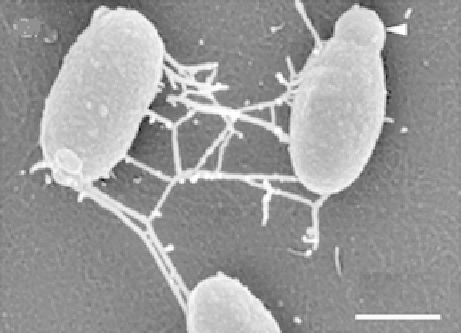Biology Reference
In-Depth Information
Figure 2.15
Budding in bacterium
Formosa agariphila
(from
Formosa agariphila
sp. nov.,
a budding bacterium of the family Flavobacteriaceae isolated from marine environments, and
amended description of the genus
Formosa
IJSEM 2006, 56, 161-167).
sexes in bacteria. From this view, the two other processes of the lateral gene transfer,
the bacterial transformation and transduction, are even less likely candidates to be
distinct modes of sexual reproduction. Parasexuality (
Otto, 2008
) may be a better
term to describe these phenomena of horizontal gene transfer in prokaryotes.
Reproduction in Single-Celled Eukaryotes
Eukaryotes (from the ancient Greek ευ (eu), “good, true,” and κάρυον (karion), ker-
nel) are characterized by the presence of a nucleus, a number of chromosomes in
which DNA is organized in form of nucleoproteins, and by a number of membrane-
bound organelles. Single-celled eukaryotes belong to two main groups: Protista and
unicellular fungi. Eukaryote unicellulars may have evolved approximately 2 bil-
lion Mya, the photosynthetic algae evolved 1600-1500 Mya, and red algae, the oldest
taxonomically identifiable eukaryote, evolved 1200 Mya (
Hedges et al., 2004
).
Single-celled eukaryotes reproduce asexually and sexually. Unicellular eukaryotes
reproduce sexually or asexually. Asexual reproduction in single-celled eukaryotes
involves mitosis, i.e., duplication of chromosomes and cytoplasm to produce “twin
cells” in the process of cell division (
Figure 2.16
).
Asexual Reproduction in Ciliates
Ciliates have two nuclei, one small (micronucleus) and the other larger
(macronucleus).

Search WWH ::

Custom Search